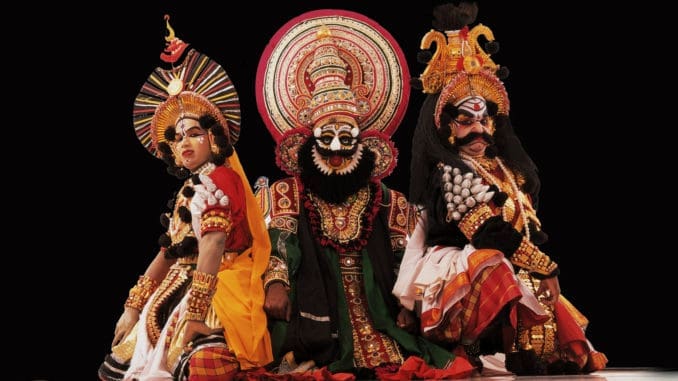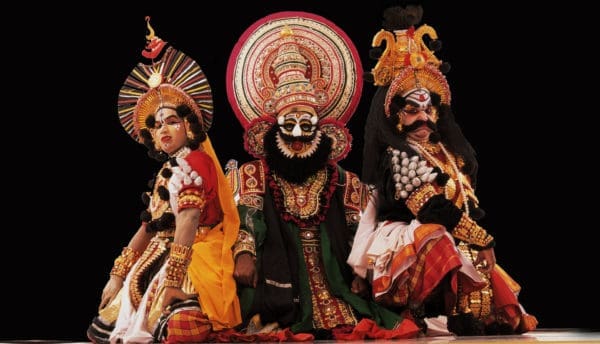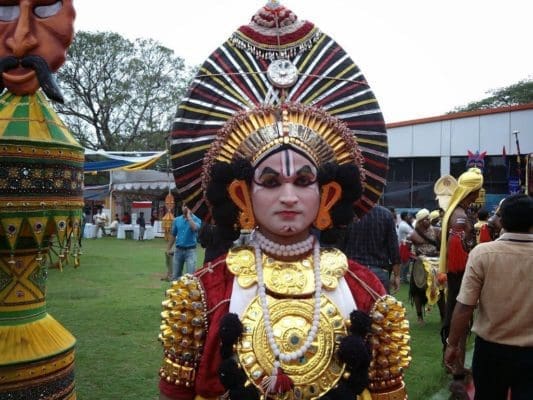

Netizens engrossed in western culture share at the very least some degree of familiarity with theatre as in recent times a lot more attention has been directed towards it through the success of shows like Hamilton and Dear Evan Hansen. However, the same degree of attention cannot be said to have been enjoyed by the theatre scene in their very own home country. India is a culturally diverse landscape after all and so every subsect of this country has its own distinct form of culture, religion, art and most importantly, theatre.
The theatre scene in India differs a fair bit from that of the west as in addition to the fairly widely recognized forms of it like dramas or musicals we also have traditional theatre which practically exists in a category of it’s own due to the uniqueness and variability of its presentation. Now, the kind of traditional theatre one might conveniently be familiarised with depends entirely upon where they are within the country as due to India’s historical and present-day diversity, different areas are home to different cultures; therefore different art forms take hold in these areas, so, for all of you residing in Udupi the theatrical art that was developed here for your viewing pleasure would be Yakshagana.

It’s a form of traditional Indian Theatre which was developed around the 16th century and incorporates music, dance and dramatic theatrical dialogue into its performances. This makes it quite a dynamic experience. It’s focused on retellings of significant Hindu epics written as both poetic prose and Puranic narrative text; however since then, it has branched out to incorporate folk tales and stories which are more focused on entertaining the audience rather than illustrating an epic as more and more ordinary folk were drawn to the art as both the audience and the performer, just in case you get the wrong idea, don’t worry it’s not as if it’s roots were abandoned so if you are in the market for something more traditional you need not worry as you’ll still find what you’re looking for. The play is still regarded as a sanctified endeavor as those who wish to be a part of a troupe can’t simply go to a theatrical institution and instead must become a part of a temple or a religious entity of similar regard which sponsors the play. This reverence and respect for the craft is religious both metaphorically and literally, adding a certain air of mystique and romance to the performers due to the pious dedication they must adhere to in order to be allowed to extend these performances to an audience as if it’s a favor granted the gods themselves.
Branching out in terms of material isn’t the only way Yakshagana has evolved as well, as even though Karnataka is a singular state it’s also divided into several regions with their own cultures, and these cultures gave birth to their own variations of the art form and so depending on where you live your experience with the play might differ from someone else’s. For people living in Udupi, the variation that subsists there would be Paduvlapaya Yakshagana.
For some trivia on the structure of a typical Yakshagana play, the troupe is mainly divided into two parts: the himmela (musicians) and the mummela (dialogue group). The himmela consists of the lead singer, who is also the lead actor and is in charge of the production. He also works alongside the people responsible for creating the instrumental score for the play amalgamating it into the musical component of the play. The mummela is made up of people who enact the play’s subject matter through dance and dialogue amalgamating into the drama side of the play. The troupe and, consequently, the venue also play a big part in the viewing experience of Yakshagana as they may choose to adhere to tradition and perform on an open-air stage with the audience seated on the ground or go for a more modern approach and organize air conditioning, chairs and host the play within an enclosed space or a tent. There’s something for everyone here; those who value convenience can experience the beauty, intensity and captivating violence of the plays, and those who are looking for a more organic experience. It is challenging to find modern theatre anywhere else except places entrenched in longstanding traditions and cultures like India.
So, now that we have gotten you familiarised with the barebone components of a typical Yakshagana play. You might be wondering where or when to go see one. Well, we’ve got you covered in that regard as well, and fortunately enough you’re in luck as from this month all the way to November, the professional, amateur, and even the student-run troupes will be in full swing, and touring the entire region of Karnataka so all you need to do is wait for a troupe to arrive near you and arrive at the venue by the crack of twilight and simply enjoy the show.




Be the first to comment